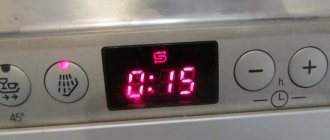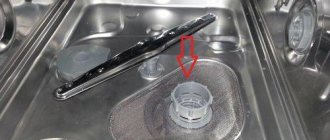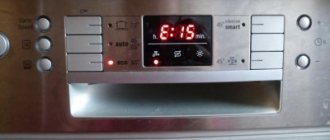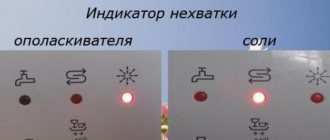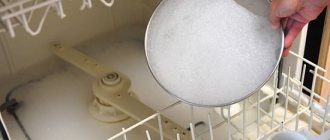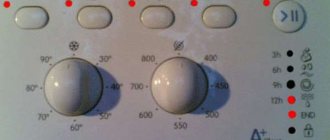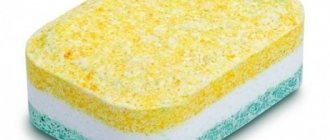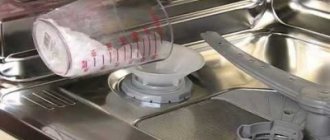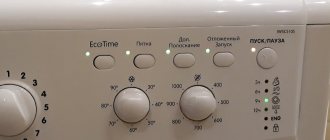Designation of icons on a BOSCH dishwasher
The control panel in dishwashers is most often located on the upper end of the lid, less often on the main part of the dishwasher body, and even less often on the front of the device.
Each manufacturer puts its own meaning into icons; let’s look at the designation of icons using the example of the most popular manufacturers of this equipment. The Bosch company today produces some of the most popular dishwashers in Europe and Russia. The most important advantage is the availability of many washing programs and the introduction of new technologies to save energy and water.
These devices have the following icons:
- pan with stand, 1 - intensive wash mode, duration 115 minutes, consumption - 21 liters;
- cup on saucer (AUTO), 2 - standard mode, 140 minutes, 19 liters;
- economical mode (ECO), 3 - maximum economical wash with soaking, 50 minutes, 140 minutes, 14 liters;
- glass with a cup on a stand and two arrows to the right, 4 - quick wash, 30 minutes, consumption - about 11 liters;
- “Shower” (drops of water), 5 - rinsing to prepare for the main washing processes, 19-20 minutes, 4 liters;
- glass - delicate mode, you can wash glass, porcelain, etc.;
- +\- with the letter H, 6 — time adjustment;
- clock with an arrow to the right, 7 - halving the cycle time;
- ½, 8 - program for unloading the machine halfway;
- pan in the machine, 9—activation of the intensive washing zone;
- baby bottle, 10 - wash at high temperatures.
Location of the control panel on the dishwasher
Depending on the model, indicators may be present under each button or on the side; some buttons are illuminated when turned on. There are also main indicators located near the “Start” button - brush - wash, END - end of cycle, tap - water supply, two arrows - salt indicator, and if the snowflake or sun is on - whether or not there is rinse aid in the system.
Dishwasher with external dashboard
It is also worth knowing the purpose of the main Start and Reset keys on some models, which can indicate the start of the machine and operating mode. The mode activation button - “START”, is surrounded by an additional drum, when moved, the washing mode is also selected.
Most of the badges from Bosch dishwashers are in Siemens dishwashers, since the company producing these types of equipment is one. Bosch is the middle segment, and Siemens is the premium segment.
Device
Each model offered by the Hansa brand has its own characteristics, but basically the PMM scheme is as follows:
- control panel equipped with a display;
- baskets for dishes (upper, lower);
- shelf for cups;
- instrument compartment;
- dispensers for detergent, rinse aid, salt;
- filters and sprayers inside the workspace;
- drain hose;
- inner tube;
- water supply hose.
How to use
The basic rules of use are as follows:
- The upper basket is designed to accommodate lightly soiled tableware made of fragile glass and porcelain. It is best to place glasses and cups here, and place cutlery horizontally between them.
- Plates and cups must be placed in such a way that they do not touch the filters and sprinklers.
- The lower basket is intended for very dirty plates, cups, for example, baking trays, bowls, salad bowls. The manufacturer recommends placing the plates upside down so that the entire surface gets water.
- Special trays (available in some models) are designed specifically to accommodate spoons and forks.
Indicators
Each Hans car has the following panel icons:
- Power supply – lights up when the equipment is plugged in.
- Half load indicator.
- Level indicator for cleaning and polishing solution (if it is on, you need to add more).
- Salt presence/absence sensor (if it lights up, you need to add salt).
Buttons
The following buttons are located on the PMM body:
- “On/Off” to stop or supply power;
- program selection button, cleaning cycle;
- half load button if less than 7 sets of dishes have accumulated;
- reboot and start.
Programs
As standard, Hansa appliances have the following dish cleaning modes:
- Standard sink for everyday use, used for dishes without dried dirt.
- Intensive mode, which makes it possible to clean even old dirt from dishes.
- Delicate mode – used for glasses and glasses without heavy soiling.
- The “hour” cycle is designed for lightly soiled dishes; there is no drying of the dishes.
- Pre-soaking – required for heavily soiled dishes, used before the main wash.
- The “eco-cleaning” mode is intended for cutlery made of crystal and porcelain to provide delicate washing and prevent chips and cracks.
Description of controls
In everyday use, a Bosch dishwasher is unlikely to cause much difficulty in use. Many lights and modes remain unused. But to use a Bosch dishwasher comfortably, you need to know what each of the signal indicators means. Let us first consider those that are present on almost all models and indicate various stages of work.
- “End” indicator – indicates the end of the dishwashing cycle.
- “Brush” indicator – lights up when the dishwasher starts.
- “Tap” indicator – signals the period of operation when the cavity of the machine is filled with hot water.
- The “Salt” indicator (two arrows in the shape of the English letter S) - indicates the presence of a salt absorbent, which helps clean the heating element from scale that has formed on it.
- The “Rinse aid” indicator (snowflake, sun, star) indicates the presence of dishwashing liquid in a special compartment.
The keys responsible for setting and regulating the upcoming wash are allocated to a separate category. The functionality of each Bosch model is very different, so only those buttons that are most common will be described.
- “Pan” - this symbol indicates an intensive mode of washing dishes at a temperature of more than 70 degrees Celsius and lasting about an hour. Used for the heaviest stains.
- “Cup and saucers” (or Auto mode) is the standard operating mode. Similar to when we wash dishes by hand. Water temperature - 50 degrees. Duration – up to two hours.
- “Cup and plates” (ECO, economy) – mode of reduced water consumption. It differs from the standard one in the presence of a rinsing stage.
- “Glass (cup) with two arrows” – accelerated washing. It passes in half an hour at a temperature of about 40 degrees Celsius.
- “Glass” – delicate mode. Used for fragile dishes.
- “Baby food bottle” – treatment of dishes with hot water, which destroys germs. Used to disinfect baby supplies (dishes, pacifiers, etc.).
Types of errors on devices with a digital display
Most modern Bosch dishwashers are equipped with such digital panels. Error indicators will light up on them if the dishwashing process failed to start. This facilitates the diagnostic process, and therefore the speed of repair. It is highly not recommended to repair such complex equipment yourself. Contact the appropriate service center. We remind you, do not forget to put your Bosch dishwasher into service mode.
- Uniform flashing of all indicators – software failure;
- E01 – control unit failure;
- E1, F1 – sensor malfunctions;
- E02 – wiring break;
- E2, F2 – heating errors;
- E03 – drying does not occur;
- E3, F3 – tank is not filled;
- E04 – see E02;
- E4, F4 – malfunction of the spray mechanism;
- E05 – see E01;
- E5, F5 – leakage or overflow of the tank;
- E06 – the chamber is not sealed (problems with the locking mechanism);
- E6, F6 – failure of the incoming water quality sensor;
- E07 – fan failure;
- E7, F7 – drain pipe clogged;
- E8, F8, E08 – low water level;
- E9, F9, E09 – problems with power supply to the heating system;
- E10, F10 – see E03, E07;
- E11, F11 – no data from the temperature sensor;
- E12, F12 – contamination of the heating element with limescale;
- E13, F13 – incoming water temperature is too high;
- E14, F14 – error in the water distribution system;
- E15, F15 – tank leak;
- E16, F16 – valve leakage;
- E17, F17 – the incoming water pressure is too powerful;
- E18, F18 – see E3, E14;
- E19, F19 – malfunction in the system;
- E20, F20 – problems with the pump;
- E21, F21 – see E3, E20;
- E22, F22 – drain system clogged;
- E23, F23 – breakdown of the pump responsible for removing water from the tank;
- E24, F24, E25, F25 – see E22;
- E26, F26 – flow sensor failure;
- E27, F27 – problems with the electrical network;
- E28, F28 – see E6;
- E29, E30, F29, F30 – see E27.
Why are dishes labeled?
The markings on the cookware indicate how functional the cookware is. Remember your grandmothers. As a rule, they had few dishes. One or two cast iron frying pans, clay pots, and everything was cooked in one oven.
Modern kitchens are equipped with ovens, stoves, and microwave ovens. Each model has its own temperature regime and cooking method. The cookware is also different - grill, non-stick, with induction support. All this requires a lot of attention when choosing. After all, ignorance can cause harm to yourself and the equipment.
This is due to the fact that the damaged surface will release substances that can harm health.
And for induction cookers, pots and pans are suitable that have a special alloy of material that forms a magnetic layer. Due to this magnetic layer, food is cooked.
When choosing dishes, the icons depicted on the surface can be misleading. To avoid troubles when cooking, you need to know what the icon means.
Thus, the marking of the cookware can tell you which stove the cookware is suitable for. After all, there are now so many types of cookers – glass ceramics, induction cookers, electric and gas. And there are ten times more materials for dishes.
Labeling is a guarantee of safety. If you choose low-quality cookware or use it for other purposes, you can get unpleasant consequences, for example, health problems. Also, an incorrectly selected pot or frying pan can cause irreparable damage to the stove and oven. Repairing equipment will not be easy, and it will also be financially expensive.
Proper care of your PMM
To avoid damage, use PMM only for dishes that can be washed in it. Do not load wooden or pewter items; not all dishwashers are suitable for washing plastic items. Don't forget to take care of the device. Wipe the doors, clean the filter. Of course, there are models with self-cleaning, but this also requires periodic supervision. The door seal should also be cleaned with a special product or a melamine sponge to prevent mold from forming or drying out.
Designations of icons on typewriters of other brands
Dishwashers from other brands have approximately 70% of the same symbols in the same interpretation as on Bosch devices, but some differences are worth knowing:
- Ariston: 3 line pot icon - rich wash, 2 rack pot icon - standard mode;
- Hansa: 3 in 1 - washing ordinary dirty dishes without dried food on them, dark saucepan with a lid - intensive washing of especially dirty dishes with dried food residues;
- Siemens - cup and glass with arrows to the right - especially fast wash at 45 degrees, 30 minutes.
Electrolux dishwashers have the least number of programs and their designation is acceptable for Ariston and Bosch. You can find out more information in the instructions for the dishwasher, where each operating mode is described in detail.
Bosch (Bosch)
Bosch dishwashers are the most needed on the Russian market. Manufacturers have created a wide range of models, a huge variety of modes and are introducing new technologies. Let's look at the decoding of frequently encountered signs (look at the numbering in the picture).
- Pan with stand (1). The sign speaks for itself - saturated mode (70 degrees), which allows you to wash heavy dirt from pots, baking sheets, and pans. Duration - 115 minutes, water consumption - 21 liters.
- Auto (cup and saucers) (2). “Automatic” mode (one might say “Standard”) takes place at a temperature of 45-65 degrees. Suitable for a variety of dishes, not including items made from savory materials. Operating time - 140 minutes, consumes 19 liters.
- ECO (Economical Cleaning) or glass and cup on a plate (3). First, a “Pre-rinse” is carried out, and then a program at 50°C. Lasts 140 minutes, wastes 14 liters.
- A glass with a cup on a stand and two arrows to the right (4) - a quick cycle without initial rinsing at 45 degrees. Properties: 30 minutes, 10 l.
- “Shower” of water drops (5) – “Pre-rinse”. The program allows you to clean dishes from food residues and prepare appliances for a painstaking wash. Time: 19 minutes, water: 4 l.
- One glass. Indicates “Delicate wash”, works at a temperature of 40 degrees. In this case, you can wash fragile items. Takes 75 minutes, wastes 15 liters.
- Plus and minus with the letter h (6) - allow you to adjust the cycle time.
- Clock with arrows to the right (7) - reducing the duration of the mode by half (VarioSpeed).
- ½ (8) – half load mode. If you haven't collected dirty dishes for a full cycle, load only half with a 30% resource saving.
- Pan with rocker arms (9) - “Intensive Zone”. Water flows into the lower part under stronger pressure than into the upper part.
- Baby bottle (10) - the hygienic mode allows you to process dishes at the highest temperature. Excellent disinfection of children's dishes.
The Start and Reset buttons on the panel will help you start the washing cycle or perform a reboot.
In addition, the dishwasher control is equipped with operation indicators. They report to the user about this or that program. Let's figure out how to understand the meaning of the light bulbs on the Bosch panel.
- Brush (1) – washing indicator.
- End (2) — end of the program.
- The faucet icon (3) is a water supply light.
- Wave-shaped arrows (4) indicate the presence or absence of salt in the ion exchanger.
- Sun (snowflake) (5) - presence of rinse aid in the compartment.
In dishwashers with a screen, the wash modes are also equipped with lights. If they shine, the program goes on.
- Icon (1) - the ability to select a temperature in the region of 65-75°C.
- Auto (2) — automatic washing.
- The “–” symbol indicates a temperature range from 35 to 45 degrees.
- Eco (4) - economical program.
- Glass and cup on a stand (5) - fast washing.
- Water jets (6) - pre-rinse.
There is also a time indicator on the floor and on the screen. In the first case, numbers are displayed on the floor that indicate the time until the end of the program. The latest models have a "Floor Beam" function. Instead of a sound signal about the end of the cycle, the machine flashes a beam.
Asko (Asko)
- Asterisk (My Favorite) - you can include your favorite program in the list of constant use.
- Delay — the ability to delay the start of the start.
- Pill icon (Multitabs or 3 in 1) - the machine recognizes tablet-based device cleaners.
- Plate or pan - “Standard” sink. Lasts 110-170 minutes.
- Lock - the door is blocked from accidental opening.
There may also be icons like those shown in the picture:
An annotation will help you accurately find the meaning of all the signs on the panel of your Siemens, Hansa, “Electrolux” model.
Classification of dishwashing equipment
The devices are divided into the following categories:
- Industrial dishwashers;
- Machines for household use.
- Floor units with a width of more than 45 centimeters. Photo;
- Also floor-standing, but narrow (built-in) devices, up to 45 cm wide. Photo;
- Small devices for desktop installation. Photo.
Also, dishwashing machines are distinguished according to the following characteristics:
- Capacity of the washing compartment;
- Dimensions in height and width;
- Operating modes;
- Dishwasher energy consumption class;
- Noise produced during operation of the unit;
- Economical energy and water consumption;
- Time spent washing dishes;
- And other less important parameters.
Energy efficiency classes of Bosch dishwashers
Premium class machines are designated in their labeling by the Latin letter A, where energy efficiency is indicated by the pluses A++. It should be noted that letter A indicates not only the amount of electricity saved, but also a number of other technical parameters inherent only in the premium class:
- Dishwasher washing class;
- Drying class;
- Location of assembly of this device.
Thus, for Bosch dishwashing utensils, A is a clear indication that this equipment was manufactured in Germany and not in other countries where Bosch has production facilities (China, Poland, Turkey, etc.).
There is no doubt that due to such high economic and technical indicators, category A devices are much more expensive than economy class dishwashers. But, taking into account the quality of workmanship (assembly), low cost of energy carriers, water and related materials (detergent compositions, means for the prevention of the device itself) during its subsequent operation after purchase, for people who know how to count money, buying an A+ class dishwasher + the Bosch brand does not look overly expensive.
Economy class dishwashers
Without a doubt, this technique is inferior in some of its characteristics to premium class machines. But mainly this relates to the availability of individual functions and options, and the location of technical assembly. That is, a dishwasher marked A++ can be produced in Poland, but not have another drying or washing class, which automatically transfers it to the economy category. At the same time, equipment of this class can fulfill its purpose no worse than similar ones, but standing at a higher level. But we know very well that the presence of many additional features in a device is not always in demand, but it has a significant effect on the difference in cost.
Other letter and number markings for dishwashers
Any of the models of the named equipment has a rather long row of markings and looks something like this: SPS40RU, where:
- S – a machine designed for washing dishes;
- P – width (45 cm) of the second generation, the first is designated R;
- S – separately installed device (not built-in);
- 40 – the machine uses a standard set of programs and functions. Devices with additional connected functions and options have values starting with the numbers 5 or 6;
- E – price category. In this case, the lowest. Bosch has five of them. E to U;
- RU – the country for which equipment of this type was produced.
As an additional feature, there are well-known markings indicating the country where the device was assembled.
Description of Bosch dishwasher indicators
Each signaling indicator has its own designation, which is usually printed on the control panel in the form of a picture. This allows you to quickly understand the functionality and identify a malfunction if one occurs.
- Selecting a temperature range from 65 to 75 °C ("+" sign and designation 65-75 °C).
- Means the device operates in automatic mode, without user intervention (“auto” and the designation 45-60 °C).
- Operation of the machine at low temperatures, from 35 to 45 °C (sign “-” and designation 35-45 °C).
- Enabling economy mode. The water temperature reaches an average value of 50 0C (“eco” and the designation 50 0C).
- Work in accelerated mode. The water temperature does not rise above 45 °C (drawing of quick dishwashing and designation 50 °C).
- Activate pre-rinse. Allows you to deal with dishes that are too dirty (rinse pattern).
Why might this problem occur?
The technical reasons for the malfunction were discussed above; now you need to understand the quality and correct operation and understand how long after the date of purchase of the dishwasher it can stop heating water.
Incorrect connection of the dishwasher leads to continuous supply and drainage of water without heating it. This applies to both old and new household appliances, as well as to users who want to connect the device themselves (with absolutely no understanding of the process technology). A specialist in connecting and setting up dishwashers and other household appliances can fix such a malfunction.
Before you begin any active actions, you should make sure that the water in the device is really cold and does not heat up at all. By selecting the delicate mode (30 °C) in some models of Bosch dishwashers, and setting the manual toggle switch to 90 °C, the water will be heated only to 30 °C. Some users prefer to immediately send the car for repairs without trying to understand the correctness of its functionality.
The simplest problem may be clogged filters. At the same time, the machine does not pass water in sufficient quantities, which is why the automation does not turn on the heating element and the water is not heated. You can replace the filter with a new one yourself.
Dishwasher indicators and symbols - meaning
As soon as the connection work is completed, the user understands how to start the equipment. To do this, you need to understand what the icons and indicators on the dishwasher panel mean. If you don’t have the instructions at hand or you don’t understand the manufacturer’s instructions, our article will help.
Sources
- https://cosmo-frost.ru/posudomoechnye-mashiny/chto-znachat-indikatory-i-znachki-na-posudomoechnoj-mashinev/
- https://TechnoSova.ru/dlja-chistoty-i-porjadka/posudomoechnaja-mashina/indikatory/
- https://www.bosch-home.ru/modeli/posudomoechnye-mashiny
- https://Tehnika.expert/dlya-chistoty-i-poryadka/posudomoechnaya-mashina/znachki-kak-rasshifrovat.html
- https://bistriyservice.ru/neispravnosti/posudomoechnykh-mashin/elektronika
- https://posudomoiki.vyborkuhni.ru/sovet/osnovnye-markirovki
- https://MashMaster.ru/markirovka-posudomoechnyh-bosch-i-siemens/
- https://qteck.ru/chto-oznachayut-znachki-na-posudomoechnoj-mashine.html
Type of installation and equipment
The marking of dishes for a dishwasher, as well as the designations for the equipment itself, includes different codes and symbols.
Dishes
The next symbol in the marking code is information about the type of installation of Siemens, Bosh, Hansa 2022 equipment.
- S – separately installed models.
- I - built-in units with open panels.
- V – fully built-in machines.
- U-built-in dishwashers with an open front panel and their own stainless steel facade.
The next symbol informs the user about the completeness of the models. As a rule, the equipment is indicated by numbers from 4 to 6. Models numbered 4 are devices with minimal equipment. 6 – multifunctional machines.
If after 4 or 6 the number 9 is indicated, this indicates increased noise insulation of the structure.
Energy efficiency classes
Lights up or flashes
The first and main rule: if something in the display of the dishwasher panel alarms you, look at the instructions: it is quite possible that this means one of the normal operating modes of the machine.
Symptoms: the brush-shaped indicator on the electronic display is lit or flashing
If the brush indicator lights up after the start of washing and is constantly on the panel, this is normal and means that the dishes are being washed. It’s another matter when it starts flashing - this is a clear sign of some kind of violation in the washing program. In this case, other signals may appear on the panel, including an error code: read about them in the instructions.
Symptoms: indicators blink randomly, control buttons do not respond
The most obvious reason is the failure of the “brains” of the PMM - the control board. The reason is usually moisture getting on the contacts, which leads to short circuits and failure of board elements.
Of course, only a qualified specialist can accurately determine that a faulty control unit is to blame. And an unprepared person should definitely not get into it: the consequences will be fatal, including possible breakdowns of other expensive components of the dishwasher. Usually the control module is changed or reflashed.
Flashing indicators may indicate a problem with the dishwasher. This is often how the diagnostic system works in cars without a display. By deciphering the meaning of the code, you can quickly find the location of the breakdown.
If you encounter an issue where the unit won't fill with water, don't panic. At the same time, the “Crane” and “END” diodes blink simultaneously on the panel. You can hear the valve humming, but for some reason there is no water. Here are the main reasons:
- Low pressure in the main.
- The inlet valve is closed.
- The inlet hose or strainer is clogged.
- The Aquastop leak protection has activated.
This is how you can determine what the display on your dishwasher means. In some cases, you cannot do without the help of a specialist.
If the dishwasher suddenly starts flashing, it means the program has gone wrong for some reason. You need to restart your device or turn it off. In addition, it is better to determine the malfunction in the device as quickly as possible. When the “tap” symbol or the word “end” is lit on the display, water supply is not possible due to a certain problem. Here are some of the reasons for this phenomenon.
- The dishwasher circuit board is broken.
- The shut-off valve was closed.
- The Aquastop function has been launched.
Study the control panel symbols and icons on your Bosch dishwasher in the device manual. If you have the slightest problem, contact a household appliance repair specialist. You should not try to find the problem yourself. You may have to open the block and look for the reason for the stoppage inside.
Problems and solutions
Due to improper connection and operation, users often encounter problems and breakdowns.
Filling system problems
Such problems are always associated with blockages, so you should know how to eliminate them:
- Turn the water supply valve to the “Off” position and disconnect the machine from the mains.
- Disconnect the water supply hose from the housing and check for plugs and debris. Do the same steps with the filter and mesh.
- To remove stagnant debris, place the filter in water with citric acid.
- Carry out valve diagnostics by ringing the coils; if necessary, replace worn elements.
Checking the circulation pump
It is better to check the circulation pump when there is no water injection and it does not enter the working space of the machine, because due to the circulation pump, water flows into the rocker arms and the dishwashing function is activated. Diagnostics and repairs will be necessary if you hear knocking, buzzing, or noise.
For repair you need:
- Provide normal access to the bottom of the workspace and remove the bottom panel of the housing.
- Remove the fasteners and drain pump by turning the pump clockwise.
- Remove the special clamps with an adjustable wrench and disconnect the pump, replace the non-working equipment.
- Transfer the clamps and mounting bolt from the old pump to the new element and perform the same assembly, only in reverse order.
Drain system malfunctions
If, after washing dishes, the water does not completely leave the workspace and accumulates below, it means that there is a problem with the drainage system. Often this is due to stuck and accumulated debris, to fix the problem you need to do the following:
- Remove all plates and glasses from the machine and pull the lower rocker towards you, carefully unscrew the upper rocker.
- Check sprinklers for debris. If necessary, clean the injectors using a toothpick.
- The drain filter and the metal mesh at the bottom of the working area should also be inspected and cleaned.
- If glasses or plates were chipped during the washing process, perhaps a splinter blocked the pump; Wearing gloves, it is necessary to carry out diagnostics.
Replacing the level sensor
In dishwashing equipment, the level sensor is called a pereostat; its function is to monitor the water level in the tank. Failure of this element may consist of physical wear, blockage, or malfunction of the electronic part.
Before a complete replacement, you need to check the element for blockages. To do this, you need to unscrew 2 screws from the bottom of the machine, the mounting clamp, and blow out the tube. The electronic part can be diagnosed using a multimeter.
Heating element diagnostics
The basis of the heating system is a flow-through heater, which is necessary to increase the temperature of the water when cleaning dishes. Its breakdown may be due to the inoperability of the heating element located under the bottom of the Hansa dishwasher. It is better to entrust the installation of the heating element to a specialist; for self-repair, the following is required:
- Disconnect the heating element with the pump.
- Unscrew the pump fasteners by turning them clockwise and remove the rubber seal.
- Remove all tubes and pipes, replace the non-functioning part and reassemble everything in the reverse order.
Leak
To eliminate leaks, it is necessary to identify the exact cause and location; for this, the following occurs:
- Carefully inspect the inside and outside of the dishwasher.
- Check the quality of door closure and the reliability of the door seals; if necessary, replace them.
- Inspect the rubber seals on the drain pump; their wear can also lead to leakage. In this case, it will be necessary to replace the seal or the pump completely.
- Conduct diagnostics of the hose at the inlet and outlet, if necessary, tighten the tightening elements or replace the hose.
Hansa brand PMMs are reliable, convenient and functional; for simple and long-term use, each model comes with detailed and understandable instructions.
«>
Why disposable tableware cannot be used twice
Disposable tableware cannot be used twice, because when these containers are reused, they release unsafe substances. Some of them can be poisoned immediately, others act gradually and affect the human body gradually. Scientists associate the release of toxic substances from plastic with the occurrence of diseases such as cancer, depression, Alzheimer's and others.
If we talk about plastic bottles into which mineral water is poured, then during reuse this type of plastic releases phthalate into the water. This is an unsafe toxic substance. If it enters the body regularly, it accumulates and can cause poisoning. Some of the manifestations of such poisonings may be obvious. As a result of prolonged use of this utensil, the general condition of the human body may deteriorate, including disruption of the endocrine, immune and other systems.
The information described above shows that the use of plastic utensils should be approached with caution. If possible, the use of plastic containers should be replaced with other materials, for example, paper, glass, metal and other products
And although plastic has firmly entered the life of modern people, the use of this material has its drawbacks.
How the salt indicator works
Most dishwashers are equipped with a salt indicator that can operate in three modes: resting, flashing and burning. The signal to the indicator comes directly from the sensor, which is installed in the salt tank. It is also worth examining in detail the operating modes of the indicator:
- Peace. If the indicator is in a quiet position (not lit), then there is enough salt in the tank.
- Flashing. A flashing indicator indicates that the salt in the tank is almost empty and needs to be added.
- Combustion. If the light is on, then the salt in the tank is completely empty. If you continue to operate the dishwasher without it, the ion exchanger will quickly fail.
If the dishwasher runs once with an empty salt reservoir, then perhaps nothing serious will happen. However, after 10 washes, the “insides” will begin to become covered with limescale, which will lead to their failure. You should always remember that the indicator only warns a person that the salt is running out, and does not itself add it to the tank.
Icons on the control panel: their explanation
In built-in dishwashers, the control panel is located at the end of the door. In most cases, all buttons are indicated by small icons in the form of a pan, glass, sun, etc., such icons allow you to compactly and neatly place all the necessary buttons. In freestanding dishwashers, the control panel is placed on the façade. In addition to small pictures, the buttons are sometimes labeled, but in English, which not everyone can translate. Therefore, you have to refer to the instructions more than once until you remember all the symbols.
Let's look at the different icons on different dishwashers. For example, symbols on Bosch dishwashers.
button under the number 1 (pan on a stand) – intensive washing program at a temperature of 70 0 C for very dirty dishes, you can wash pans and pots; button under the number 2 with the inscription Auto (sometimes a cup on two saucers) - automatic washing program at 45-65 0 C, you can wash various dishes, except fragile ones, and cutlery; button under the number 3 with the inscription Eco (or a glass and a mug on a plate) - an economical washing program at 50 0 C, like previous programs, includes pre-rinsing; button number 4 (a glass with a mug, or a glass with a mug and two arrows to the right) - a quick program that involves washing at 45 0 C, no pre-rinsing;
The program launch button is most often labeled “Start”, and the inscription “Reset 3 sec” means the program is rebooted when pressed for 3 seconds. In addition to the symbols indicating programs, there are also symbols on the indicators; they are the same on almost all dishwashers; you can read their explanation in the article Indicators of Bosch dishwashers.
Specification symbols
The fourth and fifth characters are elements of the dishwasher model specification that tell us about its completeness. By the fourth character we can determine which software package is available for a particular model of Bosch and Siemens dishwashers.
- If the number is 4, this means that this dishwasher model has only a basic set of programs.
- If the number is 5, this means that the dishwasher has a basic set of programs and additional functions.
- If the number is 6, this means the dishwasher has an expanded set of programs.
The fifth character tells us about the technical equipment of a particular dishwasher model. In this article, we will not give specific examples, since you can read about them in another publication called Designations on a dishwasher.
Model class
The model class is, in fact, a veiled designation of the price category to which, in the opinion of the manufacturer, this or that model of dishwasher should belong. For Bosch and Siemens dishwashers, there are five categories (aka classes).
- The lower price category is indicated by the letter “E”.
- The price category below average is indicated by the letter “N”.
- The average price category is the letter “M”.
- The upper price category is “T”.
- Elite price category – “U”.
Do not confuse the model class of a dishwasher with its energy consumption class. This is a completely different designation system, by which you can determine how economically a particular model of Bosch and Siemens dishwashers consumes electricity. You can get acquainted with the energy efficiency classes of dishwashers by looking at the picture below.
Where is it produced and where is it shipped?
The last 2 characters of the marking designation tell us in which territory the manufacturer plans to sell this model of Bosch and Siemens dishwashers. There are two main options: RU - means that a specific dishwasher model is planned to be sold in the Russian Federation, EU - means that the dishwasher is planned to be sold in the European Union.
Also of great importance are additional markings, which are usually placed on the packaging of the dishwasher or on its body. These designations tell us where that particular dishwasher was manufactured.
- SAS, SLX, SLF - made in Germany.
- SAE, SOR, SFX - made in Poland.
- SFO - made in Turkey.
- SOT – made in France.
- SLM – made in China.
In conclusion, we note that after reading this article, you will be able to decipher the marking designation of any model of Bosch or Siemens dishwashers. However, don't forget
What does fast blinking indicators mean?
So what do the dishwasher lights mean? If any indicator flashes, this means that a malfunction has occurred and the dishwasher can no longer be used. For ease of understanding, you should consider the operation of the main alarms:
- The LED next to the faucet image is lit. This means that no water is entering the machine. Reason: users often forget to open the water supply tap before starting work. In this case, the pump may be triggered (which will have a detrimental effect on service life), but the device will stop responding to any key press.
- The LED next to the brush image blinks. The pump will work, but the dishwashing will not start. Meaning: water entered the pan of the device, to which the machine responded by automatically activating the “Aqua-stop” function. To return the device to functionality, just look into the pan and remove excess liquid.
It should be remembered that some sensors are not fault indicators. These could be: sensors for water supply, activation of the pre-rinse mode, as well as measuring the level of salt in the liquid.
Installation and connection
The Hans dishwasher is quite simple to use. By following simple installation rules and recommendations, you can ensure long-term performance.
Basic rules for installing a dishwasher:
- Upon receipt and delivery, check the integrity.
- Before turning it on, be sure to ground the outlet; call a technician to do this.
- Check the power supply readings.
- During installation, turn off the power and water supply (close the valve).
An extension cord cannot be used; an original plug is required to connect to the outlet.
There are a number of the most important recommendations from the manufacturer that ensure the longevity of the machine:
- Before use, carefully read the built-in dishwasher manual and safety precautions.
- Restrict access to the car to people with mental and physical disabilities and children.
- Place sharp instruments horizontally or vertically with the sharp end down to prevent injury.
- To avoid damage, do not place heavy objects on the machine.
To eliminate breakdowns, it is better to contact professionals at certified centers.
Why disposable tableware cannot be used twice
Disposable tableware cannot be used twice, because when these containers are reused, they release unsafe substances. Some of them can be poisoned immediately, others act gradually and affect the human body gradually. Scientists associate the release of toxic substances from plastic with the occurrence of diseases such as cancer, depression, Alzheimer's and others.
If we talk about plastic bottles into which mineral water is poured, then during reuse this type of plastic releases phthalate into the water. This is an unsafe toxic substance. If it enters the body regularly, it accumulates and can cause poisoning. Some of the manifestations of such poisonings may be obvious. As a result of prolonged use of this utensil, the general condition of the human body may deteriorate, including disruption of the endocrine, immune and other systems.
The information described above shows that the use of plastic utensils should be approached with caution. If possible, the use of plastic containers should be replaced with other materials, for example, paper, glass, metal and other products
And although plastic has firmly entered the life of modern people, the use of this material has its drawbacks.
Studying the markings
Most manufactured cookware (most often on the bottom) has markings with care instructions. If the icons on the stickers indicating that the dishes are suitable for automatic washing are not crossed out, then everything is in order, you can safely put them in the dishwasher. Otherwise, you will have to wash it by hand.
In addition to this information, the graphic markings indicate the maximum and minimum water temperatures that the product can withstand when washing. Plastic that is resistant to temperature changes is designated from 20 to 200°C.
Interesting! How to wash a multicooker bowl in the dishwasher
Features of marking plastic dishes
Always pay attention to the labeling of plastic utensils. For the average person, all types of plastic look the same, and yet, not every material is suitable for contact with food, not everyone will tolerate heat or temperature changes, and certainly not all are safe for health
Plastics range from 1 to 19, but we will look at the first seven types that are used to make food containers:
- PET (PETE) - bottles are made for vegetable oil, beer, filtered or mineral water, soda. The container is intended for single use.
- HDPE (high-density low-density polyethylene) - most often used for packaging fermented milk products. Reuse is not recommended, as the material emits formaldehyde.
- PVC (polyvinyl chloride) - known as a packaging material for bottles, bags, films. Not suitable for fatty and hot foods, dangerous due to the release of vinyl chloride.
- LDPE (High Density Polyethylene) - can be used to store refrigerated foods. Shock-resistant, but does not withstand very low (for example, freezing) and high, more than 100°C, temperatures.
- PP (polypropylene) - is heat resistant and can even withstand boiling. Polypropylene dishes “tolerate” hot food and heating in the microwave, but release formaldehyde under the influence of fats and alcohol.
- PS (polystyrene) - suitable for cold drinks or foods that do not require heating. Typically disposable trays are made from this brittle plastic.
- The OTHER group includes other types of plastics. For tableware, it is most often polycarbonate, which is durable and resistant to high and low temperatures. With prolonged use, it may release carcinogenic substances.
More on Chistodar - a site about housekeeping.
Decoding symbols on metal and plastic utensils
The wealth of forms and functionality of modern cookware is breathtaking, but in practice we sometimes envy our grandmothers, whose kitchen arsenal was limited to an aluminum saucepan and a cast-iron frying pan. Each of the newest manufacturing materials requires proper handling, so for our own safety we need to know its characteristics and properties.
To inform consumers, manufacturers have developed intuitive pictograms. Take a look at these little icons - and you will understand whether it is possible to send the roasting pan directly from the refrigerator to the oven, whether a plastic container is suitable for heating food in the microwave, or whether it is permissible to wash baking pots in the dishwasher.
Labeling of cooking methods
| The cookware is suitable for cooking on a gas stove. |
| This cookware can be used to cook on a glass ceramic hob. |
| The cookware is designed for induction cookers. |
| If you have an electric stove, this product is suitable for you. |
| The cookware is suitable for cooking on a halogen stove. |
| This product can be placed in the oven. |
| The cookware is suitable for use in a microwave oven. |
Marking the rules for using cookware
Pictograms that indicate how to properly wash and store dishes, and also reveal information about the additional properties of the products.
| The dishes can be processed in the dishwasher. |
| The dishes can withstand temperature changes. |
| It is acceptable to store dishes in the freezer (sometimes the maximum freezing temperature is indicated on the icon). |
| Impact-resistant glasses, goblets and wine glasses. |
| Impact resistant plates, dishes and bowls. |
| Non-stick (Teflon) coating. |
| Natural, hygienic material that does not harm health and is recyclable. |
| The product complies with European standards and is safe for the user and the environment. |
Features of marking plastic utensils
Plastic used in the production of products that come into direct contact with food is subject to hygiene tests and certification. Manufacturers must provide their products with labels; if the dishes do not have one, you should refrain from purchasing.
Always pay attention to the symbols, even if it seems to you that all types of plastic are the same. First of all, make sure that the set of plates or glasses you like has the most important marker:
evidence of the suitability of plastic utensils for interaction with food.
“Pure” plastic is a fragile material, cracking in the light, melting in the heat. To achieve the famous strength characteristics, stabilizers are added to its composition, which make the plastic stronger and... more toxic.
Intermediates, heavy metal salts, process impurities, solvents and chemical breakdown products can penetrate food and have a negative effect on the human body.
At the same time, some types of plastic become dangerous when heated, others when washed in a dishwasher, others when cooled, etc.
An international marking has been introduced for sorting plastic - a triangle of arrows (recycling symbol) with a number inside (type of plastic) and an alphabetic abbreviation below them.
- PET or PETE - polyethylene terephthalate. This material is used to create bottles for water, juice, vegetable oil, dairy products, etc. Buy only PET bottles and do not reuse them. Crystallized polyethylene terephthalate is used to make trays for frozen ready meals that can be heated in the oven or microwave.
- HDPE (HDPE) - high density polyethylene (low pressure). It is used to make bags for water or milk, mugs, and containers for shampoos and detergents.
- PVC or PVC - polyvinyl chloride. The most insidious type of plastic, from which window profiles, furniture, floor coverings, pipes, wallpaper, containers for household chemicals are produced, as well as disposable tableware and containers for the bottled water market. Manufacturers have praised the availability of polyvinyl chloride, but consumers should be aware that over time (only 10 days is enough), a bottle made of this plastic begins to release carcinogens. Disposable PVC dishes can only be used for water!
- LDPE (LDPE) - low density polyethylene (high pressure). Used for the manufacture of bags and garbage bags, soft packaging and film. Safe for cold foods.
There is also polypropylene (PP), which can withstand high temperatures and is suitable for hot food and drinks, and polystyrene (PS), which is used in food packaging, cutlery and cups, but is only suitable for cold foods and soft drinks. Melamine dishes, in turn, are not labeled - be careful, as they contain formaldehyde, lead, manganese and cadmium, so such products are prohibited for sale in many countries.
Take a few minutes to decipher the markings on metal and plastic utensils. This way you will protect yourself from purchasing harmful products or extend the life of quality ones.
©PosudaMart, 2018
Asko
The icons on standard Asko brand dishwashers are also extremely simple and easy to understand. After the first use of the device, you can easily understand its functions, and their number depends on the model of a particular machine and its cost. Most often on the panel of such machines you can find the following icons and pictograms:
- star – the ability to add a frequently used program to the favorites list;
- Delay – delayed start option;
- tablet – the ability to use dishwashing detergent in the form of tablets;
- pan (or plate) – standard washing mode;
- lock - the ability to lock the machine door to protect it from children.
Distinctive features
When you decide to purchase a Hans dishwasher, you should learn about the features and advantages of the equipment.
These include:
- Stylish, modern design of each model . Any Hans device can fit harmoniously into the kitchen interior;
- saving . Thanks to the Hansa dishwasher you can significantly reduce electricity, water and your time, which you can devote to more important matters;
- effective cleaning . The machine can easily cope with any degree of contamination, perfectly washing each product.
Identification of signs on the dishwasher
The location of the panel depends on the type of dishwasher. If this is a built-in model, the keys and indicators are located at the end of the door. Since the front part of built-in PMMs is hinged, there is no need to place the control system on the front part of the door.
Freestanding machines are a full-fledged element of the interior, so the control panel is located on the front part. Buttons and indicators may be labeled, but often these are foreign names that cannot be understood without instructions. It is more convenient when the keys are designated by symbols: pan, snowflake, asterisk. Then the user can intuitively understand the meaning of the buttons.
Let's look at the designations of the most popular brands of dishwashers.
Bosch (Bosch)
Bosch dishwashers are the most popular on the Russian market. Manufacturers have created a wide range of models, a wide variety of modes and are introducing new technologies. Let's look at the decoding of the most common symbols (follow the numbering in the picture).
- Pan with stand (1). The symbol speaks for itself - intensive mode (70 degrees), which allows you to wash heavy dirt from pots, baking sheets, and frying pans. Duration - 115 minutes, water consumption - 21 liters.
- Auto (cup and saucers) (2). “Automatic” mode (one might say “Standard”) takes place at a temperature of 45-65 degrees. Suitable for a variety of dishes, except for items made of delicate materials. Operating time - 140 minutes, consumes 19 liters.
- ECO (Economical Cleaning) or glass and cup on a plate (3). Initially, a “Pre-rinse” is carried out, and then a program at 50°C. Lasts 140 minutes, spends 14 liters.
- A glass with a cup on a stand and two arrows to the right (4) - a quick cycle without an initial rinse at 45 degrees. Characteristics: 30 minutes, 10 l.
- “Shower” of water drops (5) – “Pre-rinse”. The program allows you to clean dishes from food residues and prepare appliances for a thorough wash. Time: 19 minutes, water: 4 l.
- One glass. Indicates “Delicate wash”, works at a temperature of 40 degrees. In this case, you can wash fragile items. Takes 75 minutes, spends 15 liters.
- Plus and minus with the letter h (6) - allow you to adjust the cycle time.
- Clock with arrows to the right (7) - reducing the duration of the mode by half (VarioSpeed).
- ½ (8) – half load mode. If you haven't collected dirty dishes for a full cycle, load only half with a 30% resource saving.
- Pan with rocker arms (9) - “Intensive Zone”. Water flows into the lower part under stronger pressure than into the upper part.
- Baby bottle (10) - the hygienic mode allows you to process dishes at high temperatures. Perfectly disinfects children's dishes.
The Start and Reset keys on the panel will help you start a wash cycle or perform a reboot.
In addition, the dishwasher control is equipped with operation indicators. They inform the user about a particular program. Let's figure out how to understand the meaning of the light bulbs on the Bosch panel.
- Brush (1) – washing indicator.
- End (2) — end of the program.
- The faucet icon (3) is a water supply light.
- Wave-shaped arrows (4) indicate the presence or absence of salt in the ion exchanger.
- Sun (snowflake) (5) - presence of rinse aid in the compartment.
In dishwashers with a display, the wash modes are also equipped with lights. If they light up, the program is running.
- Icon + (1) - the ability to select a temperature in the region of +65-75°C.
- Auto (2) — automatic washing.
- The “–” symbol indicates the temperature range from 35 to 45 degrees.
- Eco (4) - economical program.
- Glass and cup on a stand (5) - quick cleaning.
- Water jets (6) - pre-rinse.
There is also a time indicator on the floor and on the display. In the first case, numbers are displayed on the floor that indicate the time until the end of the program. The latest models have a "Floor Beam" function. Instead of a sound signal indicating the end of the cycle, the machine flashes a beam.
Suitable detergents for dishwashers
For Bosch dishwashers you can use all types of detergents offered by manufacturers of household chemicals:
- liquid;
- powder;
- compressed tablets.
The only requirement for such products is that they must be specialized (that is, intended for use in dishwashers).
It is recommended to use conditioner during the drying process. The purpose of this additive is to speed up the drying of dishes and eliminate traces of drops from their surface. The amount required for a good result can be determined in practice. If the volume of conditioner is insufficient, smudges will remain on the surface of plates and glasses. If there is an excess of it, the dishes become covered with colored stains.
Another important component for the correct operation of the device is water softening salt. Its absence can lead to the appearance of scale on the main components of the device.
We invite you to familiarize yourself with Fabric for an outdoor gazebo
Some manufacturers offer 3 in 1 products, where all of the above components are combined (Bosch Logixx Automatic dishwasher). Their main disadvantage is the inability to regulate the amount of salt.
Dishwasher users must purchase a starter kit, which is usually offered with their main purchase. You can separately purchase rinse aid, detergent tablets or special powder, as well as salt to soften tap water, which we have already discussed.
The starter kit includes all the detergents, without which it is simply impossible to operate any dishwasher - this is a mandatory minimum
The advantage of starter kits for beginners is that they already include everything you might need. In addition, they include products from the same manufacturer, which allows us to hope that their components are not only perfectly compatible, but also successfully complement each other.
Often, purchasing a set will cost less than purchasing its components, sold separately from each other.
In addition to the three absolutely necessary components, fragrances and products can be used for effective washing to help clean the car itself from grease and plaque. As a rule, they are purchased as the need for them arises.
For high-quality dishwashing, soft water with a low content of calcium salts should be used. If hard water is not softened, scale marks will form on the walls of the chamber over time. Salt allows you to bring water to a state in which the results of the equipment’s operation please its owner.
Regenerating salt for loading into the dishwasher should not be confused with ordinary table salt, which everyone has in their kitchen: this is a special substance for softening tap water
Bosch machines can use any detergent that is on sale today.
It can be:
- compressed tablets;
- powder;
- liquids.
The only restriction that must be strictly observed: these must be special substances intended for loading into dishwashers. Do not use chemicals to wash dishes manually.
The detergents used must be intended for processing dishes specifically in dishwashers, and those used for manual washing cannot be used
Depending on the composition of their components, there are three types of dishwasher detergents:
- with chlorine and phosphates;
- without chlorine, but with phosphates;
- without phosphates and without chlorine.
If there are no phosphates in the composition of the product, a white coating may form on the walls of the chamber and on the dishes themselves. To avoid such consequences, you have to increase the consumption of detergent.
The absence of chlorine will not provide the desired effect if the dishes need to be bleached. Dark deposits on cups and grayed plastic may be the result of a lack of chlorine. The situation can be saved by washing with increased intensity or increasing the consumption of detergent.
When using rinse aid, which enters the chamber at the last stage of washing, water drops do not leave marks on the dishes.
If you do not use this preparation while the machine is operating, then after drying, unaesthetic stains will remain on the glassware. In addition, it is high-quality dishwasher rinse aid that ensures clean dishes shine.
Rinse aids give the glass that same gloss and shine that any housewife strives for, but it is important to use them in moderation so that the dishes do not become sticky and are not covered with whitish or rainbow stains
The volume of rinse aid can be changed depending on need. If this liquid was not enough, you will see a white coating on the plates and they will be dull. In this case, the dose is increased. Excess of the drug will appear as rainbow stains on the pans. They will also feel sticky to the touch.
There are combination drugs that are called “three in one”. They contain all three components listed above. The disadvantage of such products is the inability to adjust the salt content, as recommended by Bosch equipment manufacturers.
Water that is too hard impairs the quality of washing, and water that is too soft contributes to glass corrosion: calcium is washed out of its composition. If you have to wash silver products, you must use detergents specially designed for this purpose. Others won't work.
You can see the order in which detergents are loaded and which compartments of the cuvette located on the inner surface of the door are filled with in the videos that we invite you to watch. They are in the last part of the article.
What does the rinse aid icon look like?
Dishwasher cases are always equipped with special markings to better guide the user in functions and modes. Moreover, most often the icons are not glued or drawn on the surface, but rather pressed onto the plastic, so they won’t go anywhere. The identification icon of the rinse aid compartment, as a rule, has the shape of a sun (a circle with rays diverging in different directions). Another hint is the wheel that adjusts the intensity of the rinse aid supply to the PMM next to the compartment, so you can easily identify it.
Important! It is very important to locate the rinse aid compartment correctly. If you pour it into the main wash compartment, the product will be wasted and will not bring any benefit.
If, on the contrary, you put a washing tablet in the rinse aid compartment or add powder, the PMM will take it only at the last stage of washing and, as a result, you will get poorly washed dishes with a residue from undissolved powder. Therefore, the correct choice of compartment is the key to high-quality washing.
